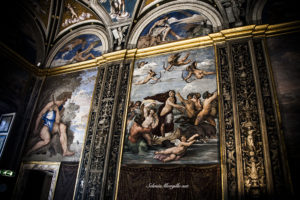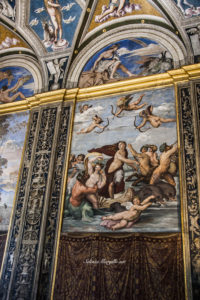Raphael’s in Rome: Triumph of Galatea
Italian Version below*
Despite countless commitments, Raphael was unable “to say no” to the banker-patron Agostino Chigi. In 1512 he asked him to fresco his villa of delights, known today as Villa Farnesina alla Lungara.
The villa was built on a project by Baldassare Peruzzi in a few years and needed decorations to be used and “celebrated” by the owner.
It seems that the initial project, entrusted to the artist from Urbino, referred to the decoration of the entire environment, one of the first that is encountered today upon entering the Villa.
In reality, Raphael only made the Triumph of Galatea on one wall and the remaining part was completed by Sebastiano del Piombo, Baldassarre Peruzzi, and Gaspard Dughet (landscapes on the walls, seventeenth-century phase).
Inspired by Ovid’s Metamorphosis, Raphael celebrates the nymph Galatea under the shooting of the arrows of the cupids at the orders of Love who leaps on a shell pulled by dolphins, fleeing Polyphemus, present on the next wall, and made by Sebastiano del Piombo.
The story is inserted in an architectural composition of great harmony; in her movements, Galatea seems to dance and twist on herself. The bodies inevitably refer to what Michelangelo did, but with the unmistakable sweetness of Raphael.
For some critics, although not explicitly revealed, it seems that Galatea’s identity embodied Margherita Gonzaga who at the time was hesitant in giving a definitive answer to Agostino Chigi, hopelessly in love. Perhaps this would explain the ambiguity of Galatea and the choice by Raphael to change the story, not including the beloved Aci in the scene, later killed by Polyphemus.
Villa Farensina is a treasure chest, read also the post on the Loggia of Cupid and Psyche!!
As Michelangelo had achieved perfect mastery of the human body, so Raphael had managed to touch the goal towards which he had vainly inclined the previous generation: the perfect and harmonious composition of figures in free movement. (EG)
All rights reserved*
Nonostante gli innumerevoli impegni, Raffaello non seppe dire di no al banchiere-mecenate Agostino Chigi. Questi nel 1512 gli chiese di affrescare la sua villa delle delizie, nota oggi come Villa Farnesina alla Lungara.
La villa era stata realizzata su progetto di Baldassare Peruzzi in pochi anni e necessitava di decorazioni per essere utilizzata e “celebrata” dal proprietario.
Sembra che il progetto iniziale, affidato all’artista urbinate, si riferisse alla decorazione dell’intero ambiente, uno dei primi che si incontra oggi entrando nella Villa. In realtà, Raffaello realizzò solo il Trionfo di Galatea su di una parete e la restante parte fu completata da Sebastiano del Piombo, Baldassarre Peruzzi e Gaspard Dughet (paesaggi sulle pareti, fase seicentesca).
Ispirandosi alle Metamorfosi di Ovidio, Raffaello celebra la ninfa Galatea sotto il tiro delle frecce degli amorini agli ordini di Amore che balza su una conchiglia trainata da delfini, in fuga da Polifemo, presente sulla parete accanto, e realizzato da Sebastiano del Piombo.
La storia è inserita in una composizione architettonica di grande armonia; Galatea nei suoi movimenti sembra danzare ed avvitarsi su se stessa. I corpi rinviano inevitabilmente a quanto fatto da Michelangelo, ma con la dolcezza inconfondibile di Raffaello.
Per alcuni critici, anche se non esplicitamente rivelata, sembra che l’identità di Galatea incarnasse Margherita Gonzaga che all’epoca tentennava nel dare una risposta definitiva ad Agostino Chigi perdutamente innamorato. Forse così si spiegherebbe l’ambiguità di Galatea e la scelta da parte di Raffaello di variare la storia, non inserendo nella scena l’amato Aci, poi ucciso da Polifemo.
Villa Farensina è uno scrigno di tesori, leggi anche il post sulla Loggia di Amore e Psiche!!
Come Michelangelo aveva raggiunto la padronanza perfetta del corpo umano così Raffaello era riuscito a toccare la meta verso la quale aveva teso invano la generazione precedente: la composizione perfetta e armoniosa di figure in libero movimento. (E.G.)
InfoSite: Villa Farnesina
Sostieni la #culturachevince, aiuta la condivisione.

